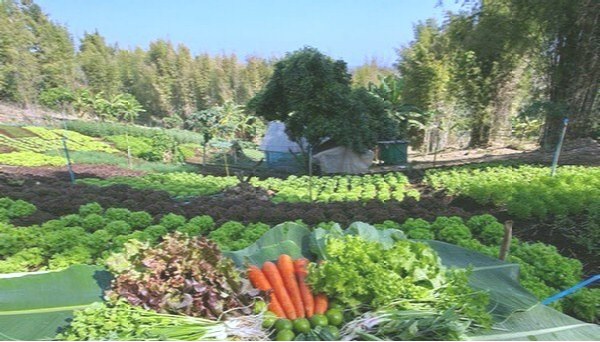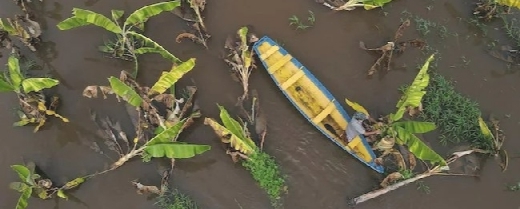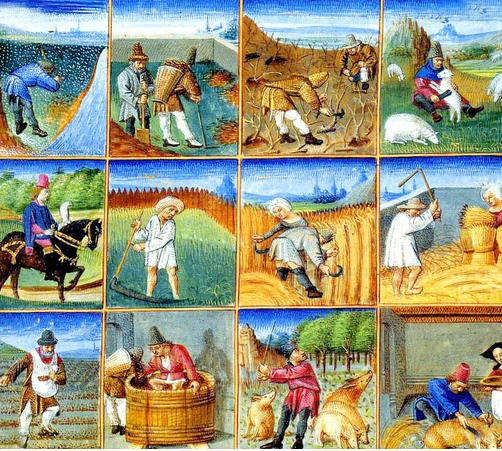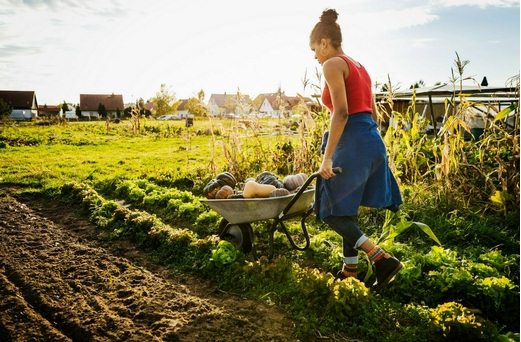SUBHEAD: Coppiced woodlands, pollarded trees, and hedgerows provided sustainable energy.
By Kris De Decker on 15 September 2020 for Low-Tech Magazine
(https://www.lowtechmagazine.com/2020/09/how-to-make-biomass-energy-sustainable-again.html)
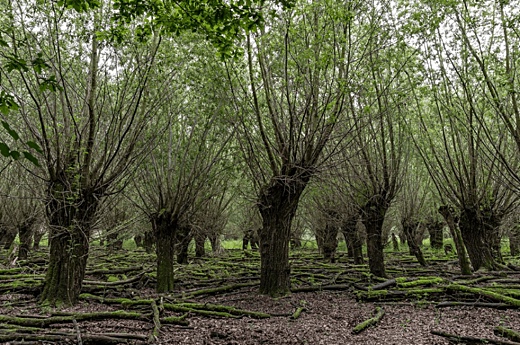
Image above:Pollarded trees in Germany are a technology worth keeping. Photo by Rene Schroder in original article.
IB Editor's note: The article has many more images of coppiced and pollarded wood farms in Europe that have operated for centuries.
From the Neolithic to the beginning of the twentieth century, coppiced
woodlands, pollarded trees, and hedgerows provided people with a
sustainable supply of energy, materials, and food.
How is Cutting Down Trees Sustainable?
Advocating for the use of biomass as a renewable source of energy –
replacing fossil fuels – has become controversial among
environmentalists. The comments on the previous article, which discussed thermoelectric stoves, illustrate this:
- “As the recent film Planet of the Humans points out, biomass a.k.a.
dead trees is not a renewable resource by any means, even though the EU
classifies it as such.”
- “How is cutting down trees sustainable?”
- “Article fails to mention that a wood stove produces more CO2 than a
coal power plant for every ton of wood/coal that is burned.”
- “This is pure insanity. Burning trees to reduce our carbon footprint is oxymoronic.”
- “The carbon footprint alone is just horrifying.”
- “The biggest problem with burning anything is once it's burned, it's gone forever.”
- “The only silly question I can add to to the silliness of this piece, is where is all the wood coming from?”
In contrast to what the comments suggest, the article does not
advocate the expansion of biomass as an energy source. Instead, it
argues that already burning biomass fires – used by roughly 40% of
today’s global population – could also produce electricity as a
by-product, if they are outfitted with thermoelectric modules.
Nevertheless, several commenters maintained their criticism after they
read the article more carefully. One of them wrote: “We should aim to
eliminate the burning of biomass globally, not make it more attractive.”
Apparently, high-tech thinking has permeated the minds of (urban)
environmentalists to such an extent that they view biomass as an
inherently troublesome energy source – similar to fossil fuels. To be
clear, critics are right to call out unsustainable practices in biomass
production.
However, these are the consequences of a relatively recent,
“industrial” approach to forestry. When we look at historical forest
management practices, it becomes clear that biomass is potentially one
of the most sustainable energy sources on this planet.
Coppicing: Harvesting Wood Without Killing Trees
Nowadays, most wood is harvested by killing trees. Before the
Industrial Revolution, a lot of wood was harvested from living trees,
which were coppiced. The principle of coppicing is based on the
natural ability of many broad-leaved species to regrow from damaged
stems or roots – damage caused by fire, wind, snow, animals, pathogens,
or (on slopes) falling rocks.
Coppice management involves the cutting
down of trees close to ground level, after which the base – called the
“stool” – develops several new shoots, resulting in a multi-stemmed
tree.
When we think of a forest or a tree plantation, we imagine it as a
landscape stacked with tall trees. However, until the beginning of the
twentieth century, at least half of the forests in Europe were coppiced,
giving them a more bush-like appearance. [1]
The coppicing of trees can be dated back to the stone age, when people
built pile dwellings and trackways crossing prehistoric fenlands using
thousands of branches of equal size – a feat that can only be
accomplished by coppicing. [2]
Ever since then, the technique formed the standard approach to wood
production – not just in Europe but almost all over the world. Coppicing
expanded greatly during the eighteenth and nineteenth centuries, when
population growth and the rise of industrial activity (glass, iron, tile
and lime manufacturing) put increasing pressure on wood reserves.
Short Rotation Cycles
Because the young shoots of a coppiced tree can exploit an already
well-developed root system, a coppiced tree produces wood faster than a
tall tree. Or, to be more precise: although its photosynthetic
efficiency is the same, a tall tree provides more biomass below ground
(in the roots) while a coppiced tree produces more biomass above ground
(in the shoots) – which is clearly more practical for harvesting. [3]
Partly because of this, coppicing was based on short rotation cycles,
often of around two to four years, although both yearly rotations and
rotations up to 12 years or longer also occurred.
Because of the short rotation cycles, a coppice forest was a very
quick, regular and reliable supplier of firewood. Often, it was cut up
into a number of equal compartments that corresponded to the number of
years in the planned rotation.
For example, if the shoots were harvested
every three years, the forest was divided into three parts, and one of
these was coppiced each year. Short rotation cycles also meant that it
took only a few years before the carbon released by the burning of the
wood was compensated by the carbon that was absorbed by new growth,
making a coppice forest truly carbon neutral. In very short rotation
cycles, new growth could even be ready for harvest by the time the old
growth wood had dried enough to be burned.
In some tree species, the stump sprouting ability decreases with age.
After several rotations, these trees were either harvested in their
entirety and replaced by new trees, or converted into a coppice with a
longer rotation. Other tree species resprout well from stumps of all
ages, and can provide shoots for centuries, especially on rich soils
with a good water supply. Surviving coppice stools can be more than
1,000 years old.
Biodiversity
A coppice can be called a “coppice forest” or a “coppice plantation”,
but in reality it was neither a forest nor a plantation – perhaps
something in between. Although managed by humans, coppice forests were
not environmentally destructive, on the contrary. Harvesting wood from
living trees instead of killing them is beneficial for the life forms
that depend on them.
Coppice forests can have a richer biodiversity than
unmanaged forests, because they always contain areas with different
stages of light and growth. None of this is true in industrial wood
plantations, which support little or no plant and animal life, and which
have longer rotation cycles (of at least twenty years).
Our forebears also cut down tall, standing trees with large-diameter
stems – just not for firewood. Large trees were only “killed” when large
timber was required, for example for the construction of ships,
buildings, bridges, and windmills. [4]
Coppice forests could contain tall trees (a “coppice-with-standards”),
which were left to grow for decades while the surrounding trees were
regularly pruned. However, even these standing trees could be partly
coppiced, for example by harvesting their side branches while they were
alive (shredding).
Multipurpose Trees
The archetypical wood plantation promoted by the industrial world
involves regularly spaced rows of trees in even-aged, monocultural
stands, providing a single output – timber for construction, pulpwood
for paper production, or fuelwood for power plants.
In contrast, trees
in pre-industrial coppice forests had multiple purposes. They provided
firewood, but also construction materials and animal fodder.
The targeted wood dimensions, determined by the use of the shoots,
set the rotation period of the coppice. Because not every type of wood
was suited for every type of use, coppiced forests often consisted of a
variety of tree species at different ages.
Several age classes of stems
could even be rotated on the same coppice stool (“selection coppice”),
and the rotations could evolve over time according to the needs and
priorities of the economic activities.
Coppiced wood was used to build almost anything that was needed in a community. [5]
For example, young willow shoots, which are very flexible, were braided
into baskets and crates, while sweet chestnut prunings, which do not
expand or shrink after drying, were used to make all kinds of barrels.
Ash and goat willow, which yield straight and sturdy wood, provided the
material for making the handles of brooms, axes, shovels, rakes and
other tools.
Young hazel shoots were split along the entire length, braided
between the wooden beams of buildings, and then sealed with loam and cow
manure – the so-called wattle-and-daub construction. Hazel shoots also
kept thatched roofs together.
Alder and willow, which have almost
limitless life expectancy under water, were used as foundation piles and
river bank reinforcements. The construction wood that was taken out of a
coppice forest did not diminish its energy supply: because the
artefacts were often used locally, at the end of their lives they could
still be burned as firewood.
Coppice forests also supplied food. On the one hand, they provided
people with fruits, berries, truffles, nuts, mushrooms, herbs, honey,
and game. On the other hand, they were an important source of winter
fodder for farm animals. Before the Industrial Revolution, many sheep
and goats were fed with so-called “leaf fodder” or “leaf hay” – leaves
with or without twigs. [6]
Elm and ash were among the most nutritious species, but sheep also
got birch, hazel, linden, bird cherry and even oak, while goats were
also fed with alder. In mountainous regions, horses, cattle, pigs and
silk worms could be given leaf hay too. Leaf fodder was grown in
rotations of three to six years, when the branches provided the highest
ratio of leaves to wood. When the leaves were eaten by the animals, the
wood could still be burned.
Pollards & Hedgerows
Coppice stools are vulnerable to grazing animals, especially when the
shoots are young. Therefore, coppice forests were usually protected
against animals by building a ditch, fence or hedge around them. In
contrast, pollarding allowed animals and trees to be mixed on
the same land. Pollarded trees were pruned like coppices, but to a
height of at least two metres to keep the young shoots out of reach of
grazing animals.
Wooded meadows and wood pastures – mosaics of pasture and forest –
combined the grazing of animals with the production of fodder, firewood
and/or construction wood from pollarded trees. “Pannage” or “mast
feeding” was the method of sending pigs into pollarded oak forests
during autumn, where they could feed on fallen acorns.
The system formed
the mainstay of pork production in Europe for centuries. [7]
The “meadow orchard” or “grazed orchard” combined fruit cultivation and
grazing -- pollarded fruit trees offered shade to the animals, while
the animals could not reach the fruit but fertilised the trees.
While agriculture and forestry are now strictly separated activities,
in earlier times the farm was the forest and vice versa. It would make a
lot of sense to bring them back together, because agriculture and
livestock production – not wood production – are the main drivers of
deforestation.
If trees provide animal fodder, meat and dairy production
should not lead to deforestation. If crops can be grown in fields with
trees, agriculture should not lead to deforestation. Forest farms would
also improve animal welfare, soil fertility and erosion control.
Line Plantings
Extensive plantations could consist of coppiced or pollarded trees,
and were often managed as a commons. However, coppicing and pollarding
were not techniques seen only in large-scale forest management. Small
woodlands in between fields or next to a rural house and managed by an
individual household would be coppiced or pollarded.
A lot of wood was
also grown as line plantings around farmyards, fields and meadows, near
buildings, and along paths, roads and waterways. Here, lopped trees and
shrubs could also appear in the form of hedgerows, thickly planted hedges. [8]
Although line plantings are usually associated with the use of
hedgerows in England, they were common in large parts of Europe. In
1804, English historian Abbé Mann expressed his surprise when he wrote
about his trip to Flanders (today part of Belgium):
“All fields are
enclosed with hedges, and thick set with trees, insomuch that the whole
face of the country, seen from a little height, seems one continued
wood”.
Typical for the region was the large number of pollarded trees. [8]
Like coppice forests, line plantings were diverse and provided people
with firewood, construction materials and leaf fodder. However, unlike
coppice forests, they had extra functions because of their specific
location. [9] One of these was plot
separation: keeping farm animals in, and keeping wild animals or cattle
grazing on common lands out. Various techniques existed to make
hedgerows impenetrable, even for small animals such as rabbits.
Around
meadows, hedgerows or rows of very closely planted pollarded trees
(“pollarded tree hedges”) could stop large animals such as cows. If
willow wicker was braided between them, such a line planting could also
keep small animals out. [8]
Trees and line plantings also offered protection against the weather.
Line plantings protected fields, orchards and vegetable gardens against
the wind, which could erode the soil and damage the crops. In warmer
climates, trees could shield crops from the sun and fertilize the soil.
Pollarded lime trees, which have very dense foliage, were often planted
right next to wattle-and-daub buildings in order to protect them from
wind, rain and sun. [10]
Dunghills were protected by one or more trees, preventing the
valuable resource from evaporating due to sun or wind. In the yard of a
watermill, the wooden water wheel was shielded by a tree to prevent the
wood from shrinking or expanding in times of drought or inactivity. [8]
Location Matters
Along paths, roads and waterways, line plantings had many of the same
location-specific functions as on farms. Cattle and pigs were hoarded
over dedicated droveways lined with hedgerows, coppices and/or pollards.
When the railroads appeared, line plantings prevented collisions with
animals. They protected road travellers from the weather, and marked the
route so that people and animals would not get off the road in a snowy
landscape. They prevented soil erosion at riverbanks and hollow roads.
All functions of line plantings could be managed by dead wood fences,
which can be moved more easily than hedgerows, take up less space,
don’t compete for light and food with crops, and can be ready in a short
time. [11]
However, in times and
places were wood was scarce a living hedge was often preferred (and
sometimes obliged) because it was a continuous wood producer, while a dead wood fence was a continuous wood consumer.
A dead wood fence may save space and time on the spot, but it implies
that the wood for its construction and maintenance is grown and
harvested elsewhere in the surroundings.
Local use of wood resources was maximised. For example, the tree that
was planted next to the waterwheel, was not just any tree. It was red
dogwood or elm, the wood that was best suited for constructing the
interior gearwork of the mill. When a new part was needed for repairs,
the wood could be harvested right next to the mill.
Likewise, line
plantings along dirt roads were used for the maintenance of those roads.
The shoots were tied together in bundles and used as a foundation or to
fill up holes. Because the trees were coppiced or pollarded and not cut
down, no function was ever at the expense of another.
Nowadays, when people advocate for the planting of trees, targets are
set in terms of forested area or the number of trees, and little
attention is given to their location – which could even be on the other
side of the world. However, as these examples show, planting trees
closeby and in the right location can significantly optimise their
potential.
Shaped by Limits
Coppicing has largely disappeared in industrial societies, although
pollarded trees can still be found along streets and in parks. Their
prunings, which once sustained entire communities, are now considered
waste products. If it worked so well, why was coppicing abandoned as a
source of energy, materials and food? The answer is short: fossil fuels.
Our forebears relied on coppice because they had no access to fossil
fuels, and we don’t rely on coppice because we have.
Most obviously, fossil fuels have replaced wood as a source of energy
and materials. Coal, gas and oil took the place of firewood for
cooking, space heating, water heating and industrial processes based on
thermal energy. Metal, concrete and brick – materials that had been
around for many centuries – only became widespread alternatives to wood
after they could be made with fossil fuels, which also brought us
plastics.
Artificial fertilizers – products of fossil fuels – boosted
the supply and the global trade of animal fodder, making leaf fodder
obsolete. The mechanisation of agriculture – driven by fossil fuels –
led to farming on much larger plots along with the elimination of trees
and line plantings on farms.
Less obvious, but at least as important, is that fossil fuels have
transformed forestry itself. Nowadays, the harvesting, processing and
transporting of wood is heavily supported by the use of fossil fuels,
while in earlier times they were entirely based on human and animal
power – which themselves get their fuel from biomass. It was the
limitations of these power sources that created and shaped coppice
management all over the world.
Wood was harvested and processed by hand, using simple tools such as
knives, machetes, billhooks, axes and (later) saws. Because the labour
requirements of harvesting trees by hand increase with stem diameter, it
was cheaper and more convenient to harvest many small branches instead
of cutting down a few large trees.
Furthermore, there was no need to
split coppiced wood after it was harvested. Shoots were cut to a length
of around one metre, and tied together in “faggots”, which were an easy
size to handle manually.
To transport firewood, our forebears relied on animal drawn carts
over often very bad roads. This meant that, unless it could be
transported over water, firewood had to be harvested within a radius of
at most 15-30 km from the place where it was used. [12]
Beyond those distances, the animal power required for transporting the
firewood was larger than its energy content, and it would have made more
sense to grow firewood on the pasture that fed the draft animal. [13]
T
here were some exceptions to this rule. Some industrial activities,
like iron and potash production, could be moved to more distant forests –
transporting iron or potash was more economical than transporting the
firewood required for their production. However, in general, coppice
forests (and of course also line plantings) were located in the
immediate vicinity of the settlement where the wood was used.
In short, coppicing appeared in a context of limits. Because of its
faster growth and versatile use of space, it maximised the local wood
supply of a given area. Because of its use of small branches, it made
manual harvesting and transporting as economical and convenient as
possible.
Can Coppicing be Mechanised?
From the twentieth century onwards, harvesting was done by motor saw,
and since the 1980s, wood is increasingly harvested by powerful
vehicles that can fell entire trees and cut them on the spot in a matter
of minutes.
Fossil fuels have also brought better transportation
infrastructures, which have unlocked wood reserves that were
inaccessible in earlier times. Consequently, firewood can now be grown
on one side of the planet and consumed at the other.
The use of fossil fuels adds carbon emissions to what used to be a
completely carbon neutral activity, but much more important is that it
has pushed wood production to a larger – unsustainable – scale. [14]
Fossil fueled transportation has destroyed the connection between
supply and demand that governed local forestry. If the wood supply is
limited, a community has no other choice than to make sure that the wood
harvest rate and the wood renewal rate are in balance. Otherwise, it
risks running out of fuelwood, craft wood and animal fodder, and it
would be abandoned.
Likewise, fully mechanised harvesting has pushed forestry to a scale
that is incompatible with sustainable forest management. Our forebears
did not cut down large trees for firewood, because it was not
economical.
Today, the forest industry does exactly that because
mechanisation makes it the most profitable thing to do. Compared to
industrial forestry, where one worker can harvest up to 60 m3 of wood
per hour, coppicing is extremely labour-intensive.
Consequently, it
cannot compete in an economic system that fosters the replacement of
human labour with machines powered by fossil fuels.
Some scientists and engineers have tried to solve this by demonstrating coppice harvesting machines.
[15]
However, mechanisation is a slippery slope. The machines are only
practical and economical on somewhat larger tracts of woodland (>1
ha) which contain coppiced trees of the same species and the same age,
with only one purpose (often fuelwood for power generation).
As we have
seen, this excludes many older forms of coppice management, such as the
use of multipurpose trees and line plantings. Add fossil fueled
transportation to the mix, and the result is a type of industrial
coppice management that brings few improvements.
Sustainable forest management is essentially local and manual. This
doesn’t mean that we need to copy the past to make biomass energy
sustainable again.
For example, the radius of the wood supply could be
increased by low energy transport options, such as cargo bikes and aerial ropeways,
which are much more efficient than horse or ox drawn carts over bad
roads, and which could be operated without fossil fuels.
Hand tools have
also improved in terms of efficiency and ergonomics. We could even use
motor saws that run on biofuels – a much more realistic application than
their use in car engines. [16]
The Past Lives On
This article has compared industrial biomass production with
historical forms of forest management in Europe, but in fact there was
no need to look to the past for inspiration. The 40% of the global
population consisting of people in poor societies that still burn wood
for cooking and water and/or space heating, are no clients of industrial
forestry. Instead, they obtain firewood in much of the same ways that
we did in earlier times, although the tree species and the environmental
conditions can be very different. [17]
A 2017 study calculated that the wood consumption by people in
“developing” societies – good for 55% of the global wood harvest and
9-15% of total global energy consumption – only causes 2-8% of
anthropogenic climate impacts. [18]
Why so little? Because around two-thirds of the wood that is harvested
in developing societies is harvested sustainably, write the scientists.
People collect mainly dead wood, they grow a lot of wood outside the
forest, they coppice and pollard trees, and they prefer the use of
multipurpose trees, which are too valuable to cut down.
The motives are
the same as those of our ancestors: people have no access to fossil
fuels and are thus tied to a local wood supply, which needs to be
harvested and transported manually.
These numbers confirm that it is not biomass energy that’s
unsustainable. If the whole of humanity would live as the 40% that still
burns biomass regularly, climate change would not be an issue. What is
really unsustainable is a high energy lifestyle.
We can obviously not
sustain a high-tech industrial society on coppice forests and line
plantings alone. But the same is true for any other energy source,
including uranium and fossil fuels.


